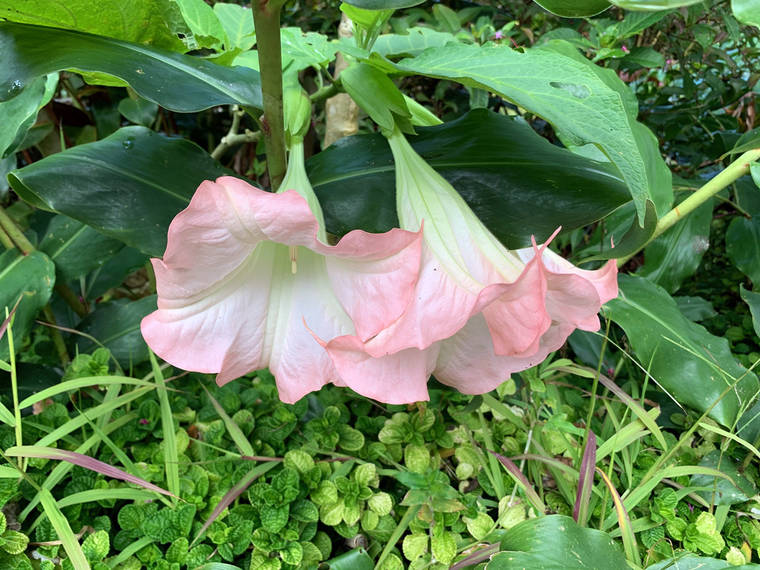Relatively speaking, we live in one of the safest places on the planet. Our temperatures change very little from season to season. Local folks and visitors alike often feel that our islands have few dangers except for volcanic eruptions, earthquakes and hurricanes. These are rare. Excessive exposure to the sun can be dangerous and people die every year by being careless at the beach or hiking in the mountains.
Although there are few poisonous native plants, some common exotic landscape plants are toxic such as oleander, crotons and angel trumpets. Some people can experience skin reactions like exposure to poison ivy from cashew and mango trees. For example, the long slender branches of Oleander look perfect for roasting marshmallows or hot dogs over an open fire, but would render that juicy hot dog quite poisonous.
There is another kind of peril that isn’t quite so obvious and it is the destruction to our environment by accidently introducing diseases and pests. Many of the plant diseases we have today did not exist before humans arrived. A common fungus referred to as Plumeria Rust is showing up on many garden Plumeria now. This disease is relatively new to Hawaii. Symptoms show up as a rusty appearance on the underside of leaves. This causes premature yellowing and dying of leaves.
Good cultural and sanitation practices will help prevent trouble such as removing diseased parts like leaves or branches as soon as they appear infected. Treat pruning wounds with a specially prepared material to stop entrance of wood decaying organisms and wood feeding insects. For treatment of fungus diseased plants, fungicide applications should begin when disease development first appears and should continue as recommended by the manufacturer.
Algae commonly grow on the surface of soil that is moist for periods of time. This is very common during the rainy season. These minute green plants often develop in such profusion that it forms a rather thick, greenish to blackish mat. Growth of such magnitude in turf is detrimental to the grass because algae actively compete with the grass for both space and nutrients. In addition, if the algae mat dries, it forms a crust that retards or prevents the movement of water into the soil. The same conditions that favor the growth of algae also favor the growth of fungi that cause turf grass diseases. It is desirable to control both problems with one practice. Reducing the moisture level would be the ideal method, however, in many situations, this is not possible. The use of fungicides that are effective against both turf diseases and algae is an efficient method of control. Your local garden supply or nursery can assist you on the correct material to use. You may also call the Master Gardener hotline at the University of Hawaii College of Tropical Agriculture. In Hilo, the main number is 981-5199. In Kona, the main number is 322-4893.
Prevention of disease organisms is vital and also includes keeping it out of Hawaii. Some folks get unhappy when they find they can’t bring certain plants or seeds into Hawaii, or if they can, they have to go through all kinds of red tape, fumigation or extended quarantines to get the plants through. A few folks figure it is a bother to get permits and go through the proper procedure to bring plants to Hawaii. They smuggle a few plants thinking it won’t make any difference. This attitude couldn’t be further from the truth.
Florida has one of the best examples of what happens when folks get careless about clean plant introductions. Lethal yellowing, a disease of palms, killed coconut palms by the millions and is a threat to other areas like Hawaii. The disease affects coconut palms, manila palms, and Hawaiian loulu palms. If Lethal Yellowing arrived here by importing infected plants, our native palm species would soon be extinct.
This again shows we should support our State and Federal agricultural quarantines. Importing plants illegally could bring a devastating disease like this to Hawaii. There are ways to bring in new plants to Hawaii legally. The Hawaii State Department of Agriculture and USDA Plant Quarantine Office can give you the details. By following the law, hundreds of new plant introductions are being made each year. These can enrich our lives without bringing with them unwanted insects and diseases that could bring disaster to our economy.






